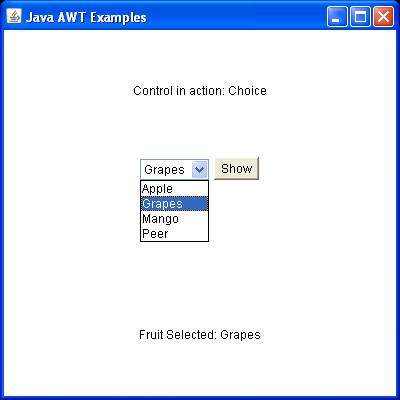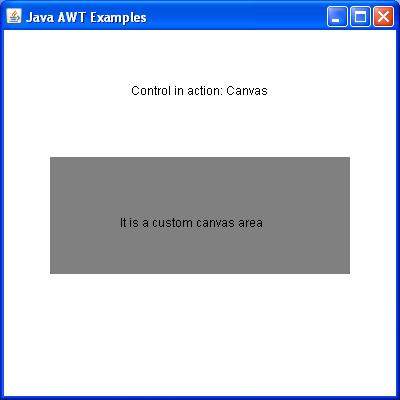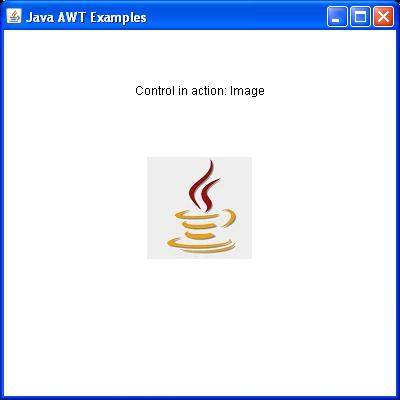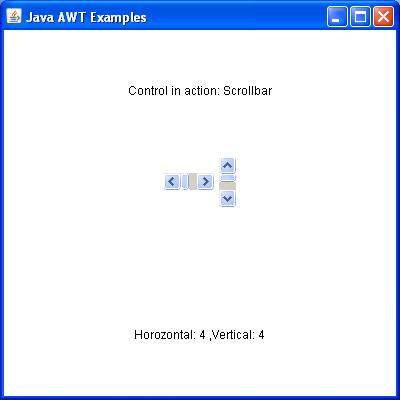Methods inherited
This class inherits methods from the following classes:- java.awt.Component
- java.lang.Object
Choice Example
Create the following java program using any editor of your choice in say D:/ > AWT > com > tutorialspoint > gui >AwtControlDemo.java
package com.tutorialspoint.gui; import java.awt.*; import java.awt.event.*; public class AwtControlDemo { private Frame mainFrame; private Label headerLabel; private Label statusLabel; private Panel controlPanel; public AwtControlDemo(){ prepareGUI(); } public static void main(String[] args){ AwtControlDemo awtControlDemo = new AwtControlDemo(); awtControlDemo.showChoiceDemo(); } private void prepareGUI(){ mainFrame = new Frame("Java AWT Examples"); mainFrame.setSize(400,400); mainFrame.setLayout(new GridLayout(3, 1)); mainFrame.addWindowListener(new WindowAdapter() { public void windowClosing(WindowEvent windowEvent){ System.exit(0); } }); headerLabel = new Label(); headerLabel.setAlignment(Label.CENTER); statusLabel = new Label(); statusLabel.setAlignment(Label.CENTER); statusLabel.setSize(350,100); controlPanel = new Panel(); controlPanel.setLayout(new FlowLayout()); mainFrame.add(headerLabel); mainFrame.add(controlPanel); mainFrame.add(statusLabel); mainFrame.setVisible(true); } private void showChoiceDemo(){ headerLabel.setText("Control in action: Choice"); final Choice fruitChoice = new Choice(); fruitChoice.add("Apple"); fruitChoice.add("Grapes"); fruitChoice.add("Mango"); fruitChoice.add("Peer"); Button showButton = new Button("Show"); showButton.addActionListener(new ActionListener() { public void actionPerformed(ActionEvent e) { String data = "Fruit Selected: " + fruitChoice.getItem(fruitChoice.getSelectedIndex()); statusLabel.setText(data); } }); controlPanel.add(fruitChoice); controlPanel.add(showButton); mainFrame.setVisible(true); } }Compile the program using command prompt. Go to D:/ > AWT and type the following command.
D:\AWT>javac com\tutorialspoint\gui\AwtControlDemo.javaIf no error comes that means compilation is successful. Run the program using following command.
D:\AWT>java com.tutorialspoint.gui.AwtControlDemoVerify the following output

AWT Canvas Class
Introduction
Canvas control represents a rectangular area where application can draw something or can receive inputs created by user.Class declaration
Following is the declaration for java.awt.Canvas class:public class Canvas extends Component implements Accessible
Class constructors
| S.N. | Constructor & Description |
|---|---|
| 1 | Canvas() Constructs a new Canvas. |
| 2 | Canvas(GraphicsConfiguration config) Constructs a new Canvas given a GraphicsConfiguration object. |
Class methods
| S.N. | Method & Description |
|---|---|
| 1 | void addNotify() Creates the peer of the canvas. |
| 2 | void createBufferStrategy(int numBuffers) Creates a new strategy for multi-buffering on this component. |
| 3 | void createBufferStrategy(int numBuffers, BufferCapabilities caps) Creates a new strategy for multi-buffering on this component with the required buffer capabilities. |
| 4 | AccessibleContext getAccessibleContext() Gets the AccessibleContext associated with this Canvas. |
| 5 | BufferStrategy getBufferStrategy() Returns the BufferStrategy used by this component. |
| 6 | void paint(Graphics g) Paints this canvas. |
| 7 | void pdate(Graphics g) Updates this canvas. |
Methods inherited
This class inherits methods from the following classes:- java.awt.Component
- java.lang.Object
Canvas Example
Create the following java program using any editor of your choice in say D:/ > AWT > com > tutorialspoint > gui >AwtControlDemo.java
package com.tutorialspoint.gui; import java.awt.*; import java.awt.event.*; public class AwtControlDemo { private Frame mainFrame; private Label headerLabel; private Label statusLabel; private Panel controlPanel; public AwtControlDemo(){ prepareGUI(); } public static void main(String[] args){ AwtControlDemo awtControlDemo = new AwtControlDemo(); awtControlDemo.showCanvasDemo(); } private void prepareGUI(){ mainFrame = new Frame("Java AWT Examples"); mainFrame.setSize(400,400); mainFrame.setLayout(new GridLayout(3, 1)); mainFrame.addWindowListener(new WindowAdapter() { public void windowClosing(WindowEvent windowEvent){ System.exit(0); } }); headerLabel = new Label(); headerLabel.setAlignment(Label.CENTER); statusLabel = new Label(); statusLabel.setAlignment(Label.CENTER); statusLabel.setSize(350,100); controlPanel = new Panel(); controlPanel.setLayout(new FlowLayout()); mainFrame.add(headerLabel); mainFrame.add(controlPanel); mainFrame.add(statusLabel); mainFrame.setVisible(true); } private void showCanvasDemo(){ headerLabel.setText("Control in action: Canvas"); controlPanel.add(new MyCanvas()); mainFrame.setVisible(true); } class MyCanvas extends Canvas { public MyCanvas () { setBackground (Color.GRAY); setSize(300, 300); } public void paint (Graphics g) { Graphics2D g2; g2 = (Graphics2D) g; g2.drawString ("It is a custom canvas area", 70, 70); } } }Compile the program using command prompt. Go to D:/ > AWT and type the following command.
D:\AWT>javac com\tutorialspoint\gui\AwtControlDemo.javaIf no error comes that means compilation is successful. Run the program using following command.
D:\AWT>java com.tutorialspoint.gui.AwtControlDemoVerify the following output

AWT Image Class
Introduction
Image control is superclass for all image classes representing graphical images.Class declaration
Following is the declaration for java.awt.Image class:public abstract class Image extends Object
Field
Following are the fields for java.awt.Image class:- protected float accelerationPriority -- Priority for accelerating this image.
- static int SCALE_AREA_AVERAGING -- Use the Area Averaging image scaling algorithm.
- static int SCALE_DEFAULT -- Use the default image-scaling algorithm.
- static int SCALE_FAST -- Choose an image-scaling algorithm that gives higher priority to scaling speed than smoothness of the scaled image.
- static int SCALE_REPLICATE -- Use the image scaling algorithm embodied in the ReplicateScaleFilter class.
- static int SCALE_SMOOTH -- Choose an image-scaling algorithm that gives higher priority to image smoothness than scaling speed.
- static Object UndefinedProperty -- The UndefinedProperty object should be returned whenever a property which was not defined for a particular image is fetched.
Class constructors
| S.N. | Constructor & Description |
|---|---|
| 1 | Image() |
Class methods
| S.N. | Method & Description |
|---|---|
| 1 | void flush() Flushes all reconstructable resources being used by this Image object. |
| 2 | float getAccelerationPriority() Returns the current value of the acceleration priority hint. |
| 3 | ImageCapabilities getCapabilities(GraphicsConfiguration gc) Returns an ImageCapabilities object which can be inquired as to the capabilities of this Image on the specified GraphicsConfiguration. |
| 4 | abstract Graphics getGraphics() Creates a graphics context for drawing to an off-screen image. |
| 5 | abstract int getHeight(ImageObserver observer) Determines the height of the image. |
| 6 | abstract Object getProperty(String name, ImageObserver observer) Gets a property of this image by name. |
| 7 | Image getScaledInstance(int width, int height, int hints) Creates a scaled version of this image. |
| 8 | abstract ImageProducer getSource() Gets the object that produces the pixels for the image. |
| 9 | abstract int getWidth(ImageObserver observer) Determines the width of the image. |
| 10 | void setAccelerationPriority(float priority) Sets a hint for this image about how important acceleration is. |
Methods inherited
This class inherits methods from the following classes:- java.lang.Object
Image Example
Create the following java program using any editor of your choice in say D:/ > AWT > com > tutorialspoint > gui >AwtControlDemo.java
package com.tutorialspoint.gui; import java.awt.*; import java.awt.event.*; public class AwtControlDemo { private Frame mainFrame; private Label headerLabel; private Label statusLabel; private Panel controlPanel; public AwtControlDemo(){ prepareGUI(); } public static void main(String[] args){ AwtControlDemo awtControlDemo = new AwtControlDemo(); awtControlDemo.showImageDemo(); } private void prepareGUI(){ mainFrame = new Frame("Java AWT Examples"); mainFrame.setSize(400,400); mainFrame.setLayout(new GridLayout(3, 1)); mainFrame.addWindowListener(new WindowAdapter() { public void windowClosing(WindowEvent windowEvent){ System.exit(0); } }); headerLabel = new Label(); headerLabel.setAlignment(Label.CENTER); statusLabel = new Label(); statusLabel.setAlignment(Label.CENTER); statusLabel.setSize(350,100); controlPanel = new Panel(); controlPanel.setLayout(new FlowLayout()); mainFrame.add(headerLabel); mainFrame.add(controlPanel); mainFrame.add(statusLabel); mainFrame.setVisible(true); } private void showImageDemo(){ headerLabel.setText("Control in action: Image"); controlPanel.add(new ImageComponent("resources/java.jpg")); mainFrame.setVisible(true); } class ImageComponent extends Component { BufferedImage img; public void paint(Graphics g) { g.drawImage(img, 0, 0, null); } public ImageComponent(String path) { try { img = ImageIO.read(new File(path)); } catch (IOException e) { e.printStackTrace(); } } public Dimension getPreferredSize() { if (img == null) { return new Dimension(100,100); } else { return new Dimension(img.getWidth(), img.getHeight()); } } } }Compile the program using command prompt. Go to D:/ > AWT and type the following command.
D:\AWT>javac com\tutorialspoint\gui\AwtControlDemo.javaIf no error comes that means compilation is successful. Run the program using following command.
D:\AWT>java com.tutorialspoint.gui.AwtControlDemoVerify the following output

AWT Scrollbar Class
Introduction
Scrollbar control represents a scroll bar component in order to enable user to select from range of values.Class declaration
Following is the declaration for java.awt.Scrollbar class:public class Scrollbar extends Component implements Adjustable, Accessible
Field
Following are the fields for java.awt.Image class:- static int HORIZONTAL --A constant that indicates a horizontal scroll bar.
- static int VERTICAL --A constant that indicates a vertical scroll bar.
Class constructors
| S.N. | Constructor & Description |
|---|---|
| 1 | Scrollbar() Constructs a new vertical scroll bar. |
| 2 | Scrollbar(int orientation) Constructs a new scroll bar with the specified orientation. |
| 3 | Scrollbar(int orientation, int value, int visible, int minimum, int maximum) Constructs a new scroll bar with the specified orientation, initial value, visible amount, and minimum and maximum values. |
Class methods
AccessibleContext getAccessibleContext()Gets the AccessibleContext associated with this Scrollbar. AdjustmentListener[] getAdjustmentListeners()
Returns an array of all the adjustment listeners registered on this scrollbar. <T extends EventListener>T[] getListeners(Class<T> listenerType)
Returns an array of all the objects currently registered as FooListeners upon this Scrollbar.
| S.N. | Method & Description |
|---|---|
| 1 | void addAdjustmentListener(AdjustmentListener l) Adds the specified adjustment listener to receive instances of AdjustmentEvent from this scroll bar. |
| 2 | void addNotify() Creates the Scrollbar's peer. |
| 3 | int getBlockIncrement() Gets the block increment of this scroll bar. |
| 4 | int getLineIncrement() Deprecated. As of JDK version 1.1, replaced by getUnitIncrement(). |
| 5 | int getMaximum() Gets the maximum value of this scroll bar. |
| 6 | int getMinimum() Gets the minimum value of this scroll bar. |
| 7 | int getOrientation() Returns the orientation of this scroll bar. |
| 8 | int getPageIncrement() Deprecated. As of JDK version 1.1, replaced by getBlockIncrement(). |
| 9 | int getUnitIncrement() Gets the unit increment for this scrollbar. |
| 10 | int getValue() Gets the current value of this scroll bar. |
| 11 | boolean getValueIsAdjusting() Returns true if the value is in the process of changing as a result of actions being taken by the user. |
| 12 | int getVisible() Deprecated. As of JDK version 1.1, replaced by getVisibleAmount(). |
| 13 | int getVisibleAmount() Gets the visible amount of this scroll bar. |
| 14 | protected String paramString() Returns a string representing the state of this Scrollbar. |
| 15 | protected void processAdjustmentEvent(AdjustmentEvent e) Processes adjustment events occurring on this scrollbar by dispatching them to any registered AdjustmentListener objects. |
| 16 | protected |
| 1 | void processEvent(AWTEvent e) Processes events on this scroll bar. |
| 17 | void removeAdjustmentListener(AdjustmentListener l) Removes the specified adjustment listener so that it no longer receives instances of AdjustmentEvent from this scroll bar. |
| 18 | void setBlockIncrement(int v) Sets the block increment for this scroll bar. |
| 19 | void setLineIncrement(int v) Deprecated. As of JDK version 1.1, replaced by setUnitIncrement(int). |
| 20 | void setMaximum(int newMaximum) Sets the maximum value of this scroll bar. |
| 21 | void setMinimum(int newMinimum) Sets the minimum value of this scroll bar. |
| 22 | void setOrientation(int orientation) Sets the orientation for this scroll bar. |
| 23 | void setPageIncrement(int v) Deprecated. As of JDK version 1.1, replaced by setBlockIncrement(). |
| 24 | void setUnitIncrement(int v) Sets the unit increment for this scroll bar. |
| 25 | void setValue(int newValue) Sets the value of this scroll bar to the specified value. |
| 26 | void setValueIsAdjusting(boolean b) Sets the valueIsAdjusting property. |
| 27 | void setValues(int value, int visible, int minimum, int maximum) Sets the values of four properties for this scroll bar: value, visibleAmount, minimum, and maximum. |
| 28 | void setVisibleAmount(int newAmount) Sets the visible amount of this scroll bar. |
Methods inherited
This class inherits methods from the following classes:- java.awt.Component
- java.lang.Object
Scrollbar Example
Create the following java program using any editor of your choice in say D:/ > AWT > com > tutorialspoint > gui >AwtControlDemo.java
package com.tutorialspoint.gui; import java.awt.*; import java.awt.event.*; public class AwtControlDemo { private Frame mainFrame; private Label headerLabel; private Label statusLabel; private Panel controlPanel; public AwtControlDemo(){ prepareGUI(); } public static void main(String[] args){ AwtControlDemo awtControlDemo = new AwtControlDemo(); awtControlDemo.showScrollbarDemo(); } private void prepareGUI(){ mainFrame = new Frame("Java AWT Examples"); mainFrame.setSize(400,400); mainFrame.setLayout(new GridLayout(3, 1)); mainFrame.addWindowListener(new WindowAdapter() { public void windowClosing(WindowEvent windowEvent){ System.exit(0); } }); headerLabel = new Label(); headerLabel.setAlignment(Label.CENTER); statusLabel = new Label(); statusLabel.setAlignment(Label.CENTER); statusLabel.setSize(350,100); controlPanel = new Panel(); controlPanel.setLayout(new FlowLayout()); mainFrame.add(headerLabel); mainFrame.add(controlPanel); mainFrame.add(statusLabel); mainFrame.setVisible(true); } private void showScrollbarDemo(){ headerLabel.setText("Control in action: Scrollbar"); final Scrollbar horizontalScroller = new Scrollbar(Scrollbar.HORIZONTAL); final Scrollbar verticalScroller = new Scrollbar(); verticalScroller.setOrientation(Scrollbar.VERTICAL); horizontalScroller.setMaximum (100); horizontalScroller.setMinimum (1); verticalScroller.setMaximum (100); verticalScroller.setMinimum (1); horizontalScroller.addAdjustmentListener(new AdjustmentListener() { @Override public void adjustmentValueChanged(AdjustmentEvent e) { statusLabel.setText("Horozontal: " +horizontalScroller.getValue() +" ,Vertical: " + verticalScroller.getValue()); } }); verticalScroller.addAdjustmentListener(new AdjustmentListener() { @Override public void adjustmentValueChanged(AdjustmentEvent e) { statusLabel.setText("Horozontal: " +horizontalScroller.getValue() +" ,Vertical: "+ verticalScroller.getValue()); } }); controlPanel.add(horizontalScroller); controlPanel.add(verticalScroller); mainFrame.setVisible(true); } }Compile the program using command prompt. Go to D:/ > AWT and type the following command.
D:\AWT>javac com\tutorialspoint\gui\AwtControlDemo.javaIf no error comes that means compilation is successful. Run the program using following command.
D:\AWT>java com.tutorialspoint.gui.AwtControlDemoVerify the following output

AWT Dialog Class
Introduction
Dialog control represents a top-level window with a title and a border used to take some form of input from the user.Class declaration
Following is the declaration for java.awt.Dialog class:public class Dialog extends Window
Field
Following are the fields for java.awt.Image class:- static Dialog.ModalityType DEFAULT_MODALITY_TYPE -- Default modality type for modal dialogs.
Class constructors
| S.N. | Constructor & Description |
|---|---|
| 1 | Dialog(Dialog owner) Constructs an initially invisible, modeless Dialog with the specified owner Dialog and an empty title. |
| 2 | Dialog(Dialog owner, String title) Constructs an initially invisible, modeless Dialog with the specified owner Dialog and title. |
| 3 | Dialog(Dialog owner, String title, boolean modal) Constructs an initially invisible Dialog with the specified owner Dialog, title, and modality. |
| 4 | Dialog(Dialog owner, String title, boolean modal, GraphicsConfiguration gc) Constructs an initially invisible Dialog with the specified owner Dialog, title, modality and GraphicsConfiguration. |
| 5 | Dialog(Frame owner) Constructs an initially invisible, modeless Dialog with the specified owner Frame and an empty title. |
| 6 | Dialog(Frame owner, boolean modal) Constructs an initially invisible Dialog with the specified owner Frame and modality and an empty title. |
| 7 | Dialog(Frame owner, String title) Constructs an initially invisible, modeless Dialog with the specified owner Frame and title. |
| 8 | Dialog(Frame owner, String title, boolean modal) Constructs an initially invisible Dialog with the specified owner Frame, title and modality. |
| 9 | Dialog(Frame owner, String title, boolean modal, GraphicsConfiguration gc) Constructs an initially invisible Dialog with the specified owner Frame, title, modality, and GraphicsConfiguration. |
| 10 | Dialog(Window owner) Constructs an initially invisible, modeless Dialog with the specified owner Window and an empty title. |
| 11 | Dialog(Window owner, Dialog.ModalityType modalityType) Constructs an initially invisible Dialog with the specified owner Window and modality and an empty title. |
| 12 | Dialog(Window owner, String title) Constructs an initially invisible, modeless Dialog with the specified owner Window and title. |
| 13 | Dialog(Window owner, String title, Dialog.ModalityType modalityType) Constructs an initially invisible Dialog with the specified owner Window, title and modality. |
| 14 | Dialog(Window owner, String title, Dialog.ModalityType modalityType, GraphicsConfiguration gc) Constructs an initially invisible Dialog with the specified owner Window, title, modality and GraphicsConfiguration |
No comments:
Post a Comment